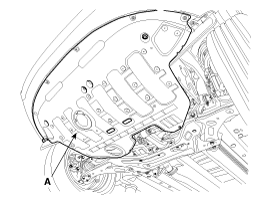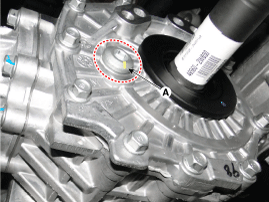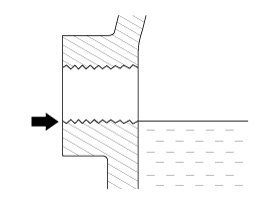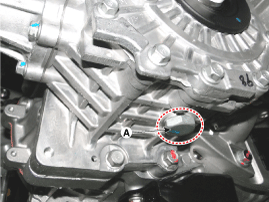 Kia Sportage: Transfer Fluid: Repair procedures
Kia Sportage: Transfer Fluid: Repair procedures
Third generation SL (2010ŌĆō2016) / Kia Sportage SL Service & Repair Manual / 4 Wheel Drive (4WD) System / Transfer Assembly / Transfer Fluid: Repair procedures
| Inspection |
|
| 1. |
Remove the under cover (A).
|
| 2. |
Remove the oil filler plug (A).
|
| 3. |
Check the oil level.
|
| 4. |
Install the oil filler plug with new gasket.
|
| 5. |
Install the under cover.
|
| Replacement |
Severe driving conditions
* Transfer oil should be replaced if the transfer assembly is fall into the water. | |||||||||||||||||
| 1. |
Remove the under cover (A).
|
| 2. |
Drain the transfer oil after loosening the drain plug (A).
|
| 3. |
Install the drain plug with new gasket.
|
| 4. |
Remove the oil filler plug (A).
|
| 5. |
Add new oil through the filler plug hole.
|
| 6. |
Install the oil filler plug with new gasket.
|
| 7. |
Install the under cover.
|
 Front Wheel Transfer Assembly: Components and Components Location
Front Wheel Transfer Assembly: Components and Components Location
Components Location
1. Automatic transaxle2. Transfer assembly3. Propeller shaft4. Coupling assembly5. Differential assembly
...
Other Information:
Air intake control
This is used to select the outside (fresh) air position or recirculated air position.
To change the air intake control position, push the control button.
Recirculated air position
With the reci ...
Check spark plugs and ignition system
Inspect your spark plugs as described in section 7 and replace them if necessary.
Also check all ignition wiring and components to be sure they are not cracked, worn
or damaged in any way. ...
Categories
- Home
- Kia Sportage QL (2015-2019) Owners Manual
- Kia Sportage QL (2015-2019) Service Manual
- Kia Sportage SL 2010-2016 Owners Manual
- Kia Sportage SL 2010-2016 Service Manual
Copyright ® www.kispmanual.com 2014-2025






